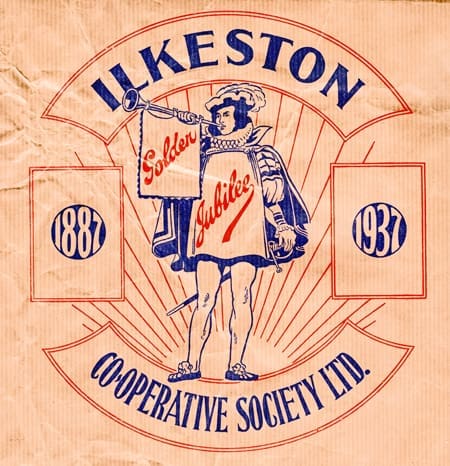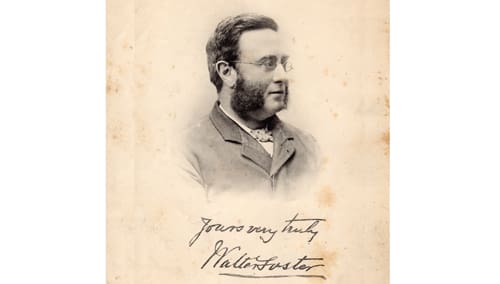(A longer read)
The complicated life of George Newman
George Newman was born in Northamptonshire in September 1834. His father John was a gamekeeper and his mother a dressmaker. The 1851 census finds George aged 16 described as an Agricultural Labourer. He has five brothers and sisters.
Life as a labourer seems to have held little appeal for George, and soon after he left for America. On 18th December 1854, aged just 20, he married Mary Elizabeth Hewitt (also born in England) in Lorain County in the State of Ohio, not so far from the shores of Lake Erie near the Canadian border. The 1860 US Census finds them in the township of Avon, Lorain County, Ohio with two young daughters.
Soon after, the American Civil War broke out and George took the Union side, being one of the first to join the new 42nd Ohio Volunteer Infantry. They were organised at Camp Chase in Columbus, Ohio in September to November 1861 and mustered in for three years’ service under Colonel James Abram Garfield. The Colonel was to become famous twenty years later when he was elected the 20th President of the United States and became the victim of an assassin’s bullet the same year.
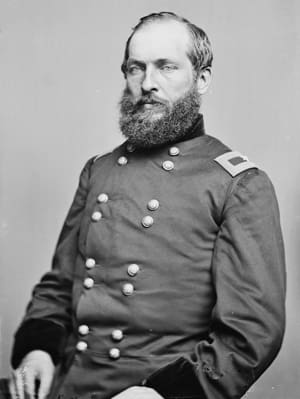
The regiment served in Ohio, West Virginia, Tennessee, with General William T. Sherman in January 1863 and in the siege of Vicksburg with General U.S. Grant in 1863. It was there at Thompson’s Hill, Mississippi on 1st May 1863 that George was wounded by a minié ball, a hollow lead rifle bullet which could cause horrific injuries. The bullet passed through his left lung and lodged under his right shoulder blade. The Siege of Vicksburg was won by the Union forces and the City’s surrender on 4th July 1863 opened up the whole Mississippi river to Union gunboats, splitting the Confederate States of America in half.
After his injury, George was no longer fit for military service and was honourably discharged with a military pension. He arrived home to find that his wife had apparently been cheating on him and had moved to Canada with another man. Following this, George was sick with fever for three months according to his friend George Clifton, with whom he stayed at this time.
Shortly after, George left to visit his parents in England. However, his condition did not improve and he had to stay on this side of the Atlantic “in poverty and terrible affliction” according to a letter his friend George Clifton wrote to President Abraham Lincoln on Christmas Eve 1864. Clifton detailed how George had fallen victim to red tape, having sworn his claim in front of an English JP instead of the US authorities. This led to further delays and his parents tried to pursue the claim via the British Embassy in Washington who said that as George had become an American Citizen there was nothing they could do. Clinton sent the Doctor’s Certificate and his letter to the President in the hope that Lincoln “would do an act of simple justice”.
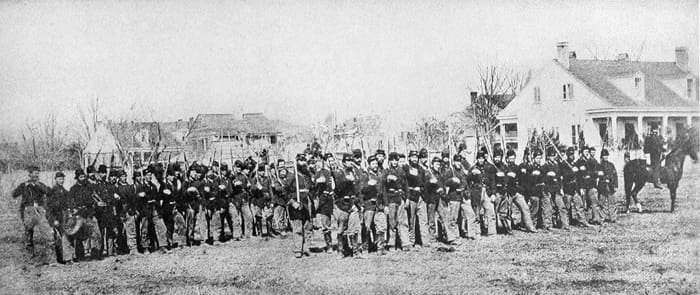
When George actually received his pension is not clear, but it was eventually paid. George was operated upon at Northampton General Hospital in 1865 when a bullet weighing an ounce and a half was extracted from his old wound.
He next appears in official records in the UK in June 1867 when in the Peterborough Registration District, he married Sarah Ann Page, who was also born in Northamptonshire. The 1871 census finds them at 41 ‘New Street’ Ilkeston [probably Station Road] and George, aged 35, is a gamekeeper. Sarah is 23 and they have children Herbert (who at 9 years old was probably George’s step-son) Bertha aged 3 and Fanny aged 4 months.

By 1881 all except George are living in Yeadon, Yorkshire. There are two younger children, Rose and George C (8 and 3 years) with Rose born in Ilkeston and George C born in Ripon. In the 1891 census they are all together again at 4 Rutland Street Ilkeston. George (52) is a gardener, and there are two more children Arthur (7) and Ada (4) born in Ilkeston. By 1901 George and Sarah are at 16 Stamford Street Ilkeston. Only Arthur and Ada live with them. Arthur is a coal cleaner underground at age 18. Ada is 13 and grandson Albert (8 years, born Ilkeston) is also living with them.
George died on 18th December 1909 aged 74 of acute bronchitis and cardiac failure following influenza, probably made worse by his old wound. He was buried in an unmarked grave in Park Cemetery, Ilkeston. The Ilkeston Pioneer carried a long article on George and his service in the U.S. Army. Eldest son George Junior was serving as a sergeant with the 2nd Battalion of the Sherwood Foresters Regiment in India at the time of his father’s death.
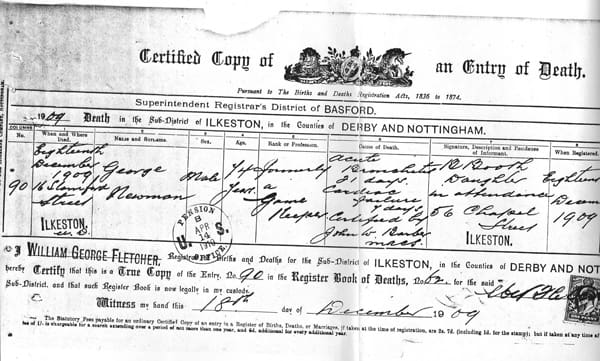
However, research has revealed another side to the story. A letter written by ‘Mrs Charles Knight’ of Avon, Ohio and dated ‘April 6, 1910’ – five months after George’s death – says:
“In reply to your letter of yesterday I will tell you all I know. It is right that George Newman was my father and there are three of us, a brother John and a sister Rose Lonsberg of Canada North Ridge. Our mother was Mary Hewitt. Father and Mother were married at French Creek. Mother has been dead a good many years but not until a long time after father was married to this woman, as far as I can find out there was no divorce on either side if there had been I am sure I should have known about it for I lived with Father’s uncle Clifton and he always knew his business pretty well as Father could not write his arm being stiff so he could only lift it straight out so his sister that he lived with in England did the writing. She died either just after he married this woman or soon after. I do not know when my father and mother were married … I was somewhere near four years old the other two younger when Father went to the war. I think I must have been about 13 when mother died but I cannot tell. … Hoping this will be right; I am respectfully yours Mrs Charles Knight.”
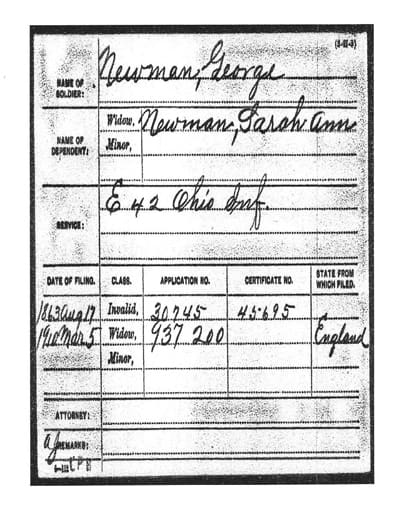
The above was probably an argument against Sarah’s U.S. Army Widow’s Pension as she was still arguing for it in 1917 – eight years later – when she swore a Declaration:
“Sarah Ann Newman, a resident of Ilkeston is the widow of George Newman who enlisted in Ohio on 10th October 1861 in Company E, 42nd Ohio Regiment and was honourably discharged 9th July 1863 and died December 1909 at Ilkeston, England. They were married on 9th May 1866 at St Luke’s Church, Peterborough, England. She had not been previously married; he had been previously married. She has not remarried. No children under 16. She was born July 19, 1843. She applied for pension on 5th March 1910 … The soldier was pensioned by ctf. No. 45,695. She appoints Milo B Stevens & Co of Washington D.C. her attorney to prosecute her claim. Her address is 9 Albion Cottage, Wilton St., Wilton Place, Ilkeston [sic]. Signed: Sarah Ann Newman.
Do we take ‘Mrs Charles Knight’ at her word? Was George’s wife still living when he married a second time? Divorce was very difficult in those days and George may well have felt that his wife had abandoned him to live with another man. It isn’t likely that we shall be able to find all the background – and the truth – behind this story.
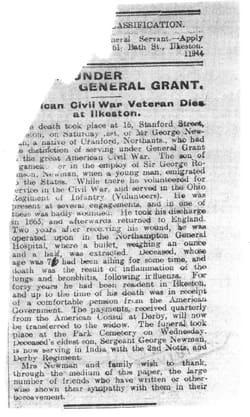
Many thanks to Michael Hammerton on the other side of the Atlantic for bringing George’s story to light. There is much more research to be done, and the interesting possibility that the United States Veterans Administration might provide an official Civil War Veteran gravestone for his unmarked grave in Park Cemetery.

